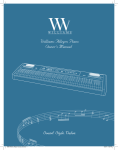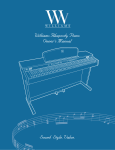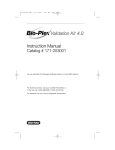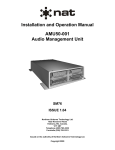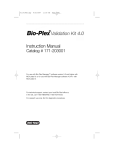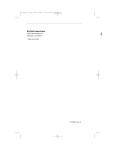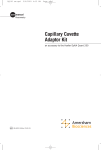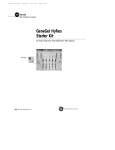Download Williams Concerto User`s manual
Transcript
Williams_Concerto-2_Q5.qxd 8/3/04 11:03 AM Page cvr1 Williams Concerto User’s Manual Digital Piano Users Manual Williams_Concerto-2_Q5.qxd 8/3/04 11:03 AM Page 1 Digital Piano Users’ Manual Thank you for purchasing the Concerto digital piano. For optimal operation and security, please read this manual carefully and keep it for future reference. Important Safety Instructions Please read the following carefully before use: • Do not expose the piano to high temperatures, direct sunlight and excessively dusty places. • Do not place the piano too close to other electrical appliances such as a television or radio, it may cause interference. • Do not place the piano in a high humidity area. Avoid putting containers with liquid on top of the piano to prevent an accidental spill which could damage the internal electronics of the piano. • Always unplug cables by gripping the plug firmly, but not pulling on the cable. • Do not apply excessive force to the switches and buttons. • When the piano is not in use or during a thunderstorm, disconnect the power supply. • Avoid adjusting the volume level to the maximum or to the level that make you feel uncomfortable. We recommend you limit the volume level to two-thirds of the max to prevent damage to the speakers and/or headphones. • Unplug the power cable before cleaning the piano and never connect or disconnect the power cable with a wet hand. • Check and clean the power plug periodically. • To avoid damage to the piano and other devices to which it is connected, turn the power switches of all related devices off prior to connecting or disconnecting cables. • Clean the piano with a dry soft cloth. A slightly damp cloth may be used to remove dirt. • Never use cleaners such as thinner or alcohol. Use a lens cleaning tissue to clean the surface of the LCD display. • If the piano cable is damaged, do not use the piano. Otherwise it may become a fire or electrical hazard. • The piano may malfunction due to improper handling, if this occurs, switch off the piano and switch on again after 30 seconds. • Do not attempted to disassemble or repair the piano by yourself. Any modification of the internal parts may void your warranty. If the piano is not working properly, please contact an approved repair facility. WARNING: To reduce the risk of fire or electric shock, do not expose this instrument to rain or moisture. CAUTION: This instrument should not be exposed to dripping or splashing and objects filled with liquids, such as vases, should not be placed on the instrument. www.williamspianos.com 1 Williams_Concerto-2_Q5.qxd 8/3/04 11:03 AM Page 2 Williams Concerto Thanks for choosing the Williams Concerto digital piano Thank you for purchasing this Digital Piano. The use of high technology and the most advanced sampling technique brings you high quality sound and enjoyment. The combination of digital piano and electronic keyboard features let you perform perfectly. We hope this skillfully built digital piano will able to explore your creativity, and brings you unlimited happiness and music enjoyment. Before you use the piano, we recommend you to read through this manual. Please keep this instruction manual for future reference. 2 Digital Piano Users Manual Williams_Concerto-2_Q5.qxd 8/3/04 11:03 AM Page 3 Digital Piano Users’ Manual Contents Digital Piano Set-up Guide . . . . . . . . . . . . . . 4 General Guide . . . . . . . . . . . . . . . . . . . . . . . . . 5 The Connectors . . . . . . . . . . . . . . . . . . . . . . .6-7 Using the AC power jack Using headphones Using AUX.OUT jack Using the foot pedals Using the MIDI IN/OUT jacks Basic Operation . . . . . . . . . . . . . . . . . . . . . . . .7 Power switch & volume Demonstration Voice and Effects . . . . . . . . . . . . . . . . . . . . .8-11 Select a voice Dual voice Harmony Drum kit Digital effects Instant select piano voice Touch Response Keyboard . . . . . . . . . . . . . .11 Octave Down Control . . . . . . . . . . . . . . . . . .11 Split Keyboard . . . . . . . . . . . . . . . . . . . . . . . .12 Playing the Styles . . . . . . . . . . . . . . . . . . . .12-14 Select a style The chord recognition modes Accompaniment control Metronome . . . . . . . . . . . . . . . . . . . . . . . . . . .15 Jam Track . . . . . . . . . . . . . . . . . . . . . . . . . . . .15 One Touch Setting . . . . . . . . . . . . . . . . . . . . .15 Memorize Panel Settings . . . . . . . . . . . . . . . .16 How to store a memorized setting www.williamspianos.com The Sequencer . . . . . . . . . . . . . . . . . . . . . . . .17 Play back the recorded song Record a new song Mixer Volume Control . . . . . . . . . . . . . . . . .18 Muting the sections Utility Functions . . . . . . . . . . . . . . . . . . . . .18-20 Change the Tempo Restoring the memorized Tempo Pan Pitch Transpose MIDI . . . . . . . . . . . . . . . . . . . . . . . . . . . . . . . .20 MIDI channel selection Control change filter Specifications . . . . . . . . . . . . . . . . . . . . . . . . .21 Troubleshooting . . . . . . . . . . . . . . . . . . . . . . .21 Appendix Appendix 1A - . . . . . . . . . . . . . . . . . . . . . .22 Single Finger Chord Chart Appendix 1B - . . . . . . . . . . . . . . . . . . . . . .23 Fingered Chord Chart Appendix 2 . . . . . . . . . . . . . . . . . . . . . . . .23 Style List Appendix 3 . . . . . . . . . . . . . . . . . . . . . . . .24 Voice List Appendix 4 Demo Song List Appendix 5 Digital Effect List 3 Williams_Concerto-2_Q5.qxd 8/3/04 11:03 AM Page 4 Williams Concerto 4 Digital Piano Users Manual Williams_Concerto-2_Q5.qxd 8/3/04 11:03 AM Page 5 Digital Piano Users’ Manual www.williamspianos.com 5 Williams_Concerto-2_Q5.qxd 8/3/04 11:03 AM Page 6 Williams Concerto The Connectors Using the AC Power Jack Connect the power cable to the AC power jack on the underside of the piano body. Ensure the piano is turned off when connecting and disconnecting the power. Turn the volume switch counter-clockwise to reach the minimum volume level. Plug the power cable into an AC power outlet. If you have done the above procedures you are now safe to turn on the piano. CAUTION: When the piano is not in use or during a thunderstorm, disconnect the power. Using Headphones An optional set of stereo headphones can be connected to the headphones jack located on the left underside of the piano body. When a pair of headphones is connected to the jack, the internal speakers will switch off automatically. CAUTION: Never use the headphones with high volume, as it may damage your sense of hearing. To prevent damage to the speakers, ensure that the volume is set to the minimum level before connecting the power and other devices. Using the AUX.OUT jack Connect the rear-panel AUX.OUT jack to amplified speakers, amplifiers or domestic hi-fi units for external amplification. Note: Connect both left (L) and right (R) channels for the stereo result. If you only connect either one of the channels, the connected channel will only take effect. 6 Digital Piano Users Manual Williams_Concerto-2_Q5.qxd 8/3/04 11:03 AM Page 7 Digital Piano Users’ Manual Using the Foot Pedals Connect the plug of the foot pedal unit to the pedal jack on the rear panel. Using the MIDI IN/OUT Jack MIDI stands for Musical Instrument Digital Interface. MIDI is a worldwide standard that makes it possible for various electronic musical instruments to communicate with other MIDI devices. MIDI IN: Data transmitted from other MIDI instrument via MIDI, is received at this terminal. MIDI OUT: Data produced by the Digital Piano is transmitted to other MIDI instruments via MIDI from this terminal. Basic Operation 1. Power Switch & Volume Turn the POWER switch on. The LCD display lights up. Use the volume control switch to adjust the volume to your desired level 2. Demonstration This Digital Piano comes with 10 demo songs for showing you the possibilities of the piano. To playback the demo songs, follow the instructions below: DEMO Press the SONG button, the demo song start to play back. There are 10 demo songs and they can play continually. When you press the SONG button during playback, the song playing currently will stop and will skip to the next song. During the playback you can use the numeric keypad or the (+) and (-) keys to select the songs. To stop playback, press the START/STOP button. Note: During the demo song playback, the digital piano is unable to play. www.williamspianos.com 7 Williams_Concerto-2_Q5.qxd 8/3/04 11:03 AM Page 8 Williams Concerto Voices and Effects Select a Voice The Voice Select mode is the default mode every time the piano is turned on and VOICE 01 is selected. At this time you can use the numeric keypad or the (+) and (-) keys to select another voice. When you are choosing Voice 01-99 at the status of VOICE 1 or VOICE 2, you can use the numeric keypad to input the number of your desired voice directly. Three digits voice number are entered by first pressing the +100 button, then press the remaining two digits in sequence. Dual Voice This digital piano features dual voice option which allow you to hear two different sounds for every note played. 1. When VOICE 1 is showing on the display, press the DUAL button, and VOICE 2 appears in the display. Now input the second voice digits. 2. Press the DUAL button again to turn this function off. NOTE: Dual Voice function only works with full keyboard playing or right-hand playing. 8 Digital Piano Users Manual Williams_Concerto-2_Q5.qxd 8/3/04 11:03 AM Page 9 Digital Piano Users’ Manual Harmony The digital piano has three different harmony settings. It transforms simple one-note melodies into fully orchestrated pieces. 1. When the piano is turned on, the harmony function is in the off status, press the HARMONY button once, then the word OFF will appear in the display. 2. When OFF is showing in the display, press HARMONY button once, at this time the select indicator points to HARMONY in the display and the harmony value switch goes from OFF to 01. Now play a key on the left side of the keyboard to turn on the auto accompaniment, then play a key on the right to hear the harmony effect. 3. When you are in harmony 01 status, press the HARMONY button once and 02 will appear in the display. If you would like to switch to harmony 03, press the HARMONY button again. Now play a single note on the right side of the keyboard. If you selected harmony type 01, you will hear two notes play. Select harmony type 02 and play the same chord and single note again, this time you will hear a three note chord on the right hand for every single note played. Select harmony type 03 and play the same chord and single note again, this time you will hear an octave intervals for every single note played. 4. To turn off the harmony function, press the HARMONY button until OFF appears in the display. Note: If the keys on the left side are in Normal or Split mode, the harmony effect will not take effect. If the Harmony function is turned on, the right side of the keyboard will take effect. During recording, the harmony effect will not work. If you start recording when the harmony function is turned on, the function will turn off automatically. Drum Kit The digital piano features 7 drum sounds. Voices 141-147 are where the drum sets are located. To select a drum set, please refer to the section “Select a Voice” on page 8. www.williamspianos.com 9 Williams_Concerto-2_Q5.qxd 8/3/04 11:03 AM Page 10 Williams Concerto Digital Effects The digital piano has 8 Reverb and 8 Chorus effects. Reverb Effect To adjust reverb type and levels: 1. Press the REVERB button, and two values appear on the display. The one on the left is the reverb type, and the other is the reverb level. 2. Press and hold the REVERB button, the reverb type will start to flash, and you then can change the reverb type by selecting a number(0-7) with the numeric keypad. When the reverb type is selected, the reverb level will start to flash, now you can use the same method as selecting reverb type to select reverb level (0-7). Chorus Effect To adjust chorus type and levels: 1. Press the CHORUS button, and two values will appear on the display. The one on the left is chorus type, the other is the chorus level. 2. Press and hold the CHORUS button, the chorus type value will start to flash. You then can change the chorus type by selecting a number (0-7) with the numeric keypad. When the chorus type is selected, the chorus level will start to flash. Now you can use the same method as selecting chorus type to select chorus level (0-7). Note: When the Reverb and Chorus levels are set to “0”, the effects are turned off. The default Reverb type and level are both set to 4; the default Chorus type and level are both set to “0”, as in “off ” status. 10 Digital Piano Users Manual Williams_Concerto-2_Q5.qxd 8/3/04 11:03 AM Page 11 Digital Piano Users’ Manual Instant Select Piano Voice You can select the piano voices immediately by pressing the PIANO button. When you press the PIANO button, the digital piano turns into Normal status automatically, and the Dual voice function is de-selected. Press the PIANO button again to exit the PIANO mode and return to the previously selected voice. If you select a voice directly in the Piano status, the PIANO status will exit automatically. Touch Response Keyboard The keyboard on this digital piano is velocity sensitive. This means the harder you play on the keys, the louder the sound becomes, just like an acoustic piano. The touch response can be turn on and off at any time. At the default, the touch response is turned on. Press the TOUCH button to turn the touch response on and off as desired. Octave Down Control When you are playing in Normal mode, you can shift the current voice down one octave in real time. In the Fingered, Single Fingered and Split mode, only the right side of the keyboard will shift down one octave. In Normal mode, press the OCTAVE DOWN button, and the octave down indicator appears in the display. Now, the entire keyboard will shift down one octave. In Fingered, Single Fingered and Split mode press the OCTAVE DOWN button, and the octave down indicator appears in the display. Now the right section of the keyboard will shift down one octave. To cancel the octave down function, press the OCTAVE DOWN button again and the octave down indicator turns off. www.williamspianos.com 11 Williams_Concerto-2_Q5.qxd 8/3/04 11:03 AM Page 12 Williams Concerto Split Keyboard To play on a split keyboard with one or two voices on the right section (Upper keyboard) and one voice on the left (Lower keyboard), press the MODE button as many times as necessary until the select indicator points to the SPLIT function. Select a Split Point 1. Press and hold the SPLIT POINT button. The display shows the current Split point setting expressed as a note on the keyboard. The default setting corresponds to note F#3. (If you release the SPLIT POINT button, the display returns to the previous view). 2. While still holding the SPLIT POINT button, press a key corresponding to the new Split point. (Note: You can also use the (+) or (-) buttons to incrementally change the split point). 3. To exit the Split mode, press the MODE button as many times as necessary until the select indicator points to NORMAL. To play with two layered sounds on the Upper keyboard and one on the lower, simply press the DUAL button while you are in SPLIT mode. Note: In the SPLIT mode, if you feel the ratio of the Lower and Upper sections does not meet your requirements, you can proceed to further adjustment with the MIXER CONTROL function as described later in this manual. Playing the Styles This digital piano contains 99 styles (01-99) and 1 metronome (00). The sophisticated Auto Accompaniment system can provide automated bass and chord backing that are perfectly matched to the selected accompaniment arrangements. Select a Style 1. Press the STYLE button, the message appears in the display. 2. Use the NUMERIC KEYPAD or the (+) and (-) keys to select a Style number. 12 Digital Piano Users Manual Williams_Concerto-2_Q5.qxd 8/3/04 11:03 AM Page 13 Digital Piano Users’ Manual The Chord Recognition Modes The digital piano allows you to choose between two different Chord modes: Single Finger mode: 1. Choose a style that you desire (01-99). 2. Press the MODE button until the select indicator points to “S.Finger”. 3. Press the START/STOP button to start to playback the style. 4. Follow the Single Finger Chord table in the appendix section and play the chord that you want. The following shows C, Cm, C7 and Cm7 as the examples of the S.Finger Chord playing method: Fingered mode: In this mode, play the keys on the left of the Split point to play the Fingered Chord that you want. 1. Choose a style that you desired (01-99). 2. Press the MODE button until the select indicator points to “Fingered”. 3. Press the START/STOP button to start to playback the style. Accompaniment Control This digital piano provides a wide variety of automatic functions that make it very easy to play. The functions are found in the Accompaniment Control section. www.williamspianos.com 13 Williams_Concerto-2_Q5.qxd 8/3/04 11:03 AM Page 14 Williams Concerto START/STOP Press the START/STOP button to start/stop the style. SYNC 1. The SYNC function allows you to synchronize the start of your Style with a note or chord pressed on the keyboard without using the START/STOP button. When you press the SYNC button, the display shows the beat pattern and FILL-IN A indicators. This puts the keyboard in standby mode. 2. If you are in Normal mode, you can start the style by playing any key on the keyboard. If you are in Fingered, S.Finger or Split modes, you have to play the chord that is corresponding to the style pattern you selected. 3. To stop the style, press either the START/STOP button or the SYNC button. Before starting the Style, press the INTRO button to place the piano on intro-start standby. The LED of the current Style pattern starts to flash to indicate that the INTRO has been preset. Now press the START/STOP button and play a note or chord on the lower part of the piano. The Style starts with an introductory pattern then it proceeds with the selected auto accompaniment. Fill in A/B Each of the 99 styles have a standard fill FILL-IN A and variation FILL-IN B. When you press the FILL-IN A or the FILL-IN B during playback, the current pattern is interrupted by an appropriate Fill-in, then it proceeds with the same pattern, depending on which button you press. Fade While playing your style, you can fade the overall volume down simply by pressing the FADE button. After pressing the button, the Style continues to play but the volume decreases gradually until no volume is heard. Ending You can stop your Style automatically with a well-executed ending pattern without using the START/STOP button. While the style is playing, simply press the ENDING button. The Style auto-accompaniment stops automatically with an ending phrase. 14 Digital Piano Users Manual Williams_Concerto-2_Q5.qxd 8/3/04 11:03 AM Page 15 Digital Piano Users’ Manual Metronome At any time, you can activate the METRONOME for practicing purposes. 1. To activate the Metronome, press the STYLE button and insert the value “00”. 2. Press the START/STOP button to start the Metronome. You can choose the metronome type (0, 2-9) by pressing the METRONOME button. 3. When the Metronome is playing, you can adjust the speed by pressing the TEMPO (+)/(-) buttons. 4. To stop the Metronome, press the START/STOP button. Jam Track 1. While the electronic keyboard is playing the auto accompaniment, you press the JAM TRACK button and the indicator lights up. In this case, the electronic keyboard will play the chord of the style according to the previous setting. Press the JAM TRACK button again, the JAM TRACK indicator turns off, and the electronic keyboard will return to normal mode. 2. In the JAM TRACK accompaniment pattern by pressing the FILL-IN A or the FILL-IN B button, the JAM TRACK function will cancel automatically. One Touch Setting The One Touch Setting is a quick and easy way of reconfiguring voices of Upper and Lower sections of a style by pressing only one button while you are playing. Selecting the One Touch Setting 1. Select a Style using the methods already described. 2. Press the OTS button. The display shows the select indicator pointing to the OTS. Make sure one of the two chord recognition modes is selected. 3. Press the START/STOP button to play the selected style. While playing the style, you can press one of the ONE TOUCH SETTING buttons - [M1], [M2], [M3], [M4] to select the appropriate setting. www.williamspianos.com 15 Williams_Concerto-2_Q5.qxd 8/3/04 11:03 AM Page 16 Williams Concerto Memorize Panel Settings If you don’t want to use the factory style settings, you can save your own panel configurations to the MEMORY buttons. This function allows you to store up to 6 user-defined configurations, including Style, Variation and other selections, which you can then recall by simply pressing a button. How to Store a Memorized Setting? You are able to store the following values into your user-define settings: 1. Voice values Voice Variation setting Mixer Control setting Touch Response On/Off Reverb, Chorus and Level setting Harmony effect setting Octave Down setting Split Keyboard setting 2. Accompaniment values Accompaniment style number Mixer Control setting FILL-IN A/B setting Intro, Ending, Fade setting Split Point setting 3. Tempo setting Mode configuration (Normal, Fingered, Single Finger, Split Keyboard) You only need to change one aspect of any factory setting to be able to save as a new setting. 1. Press the STYLE button, then press the OTS button, use the numeric keypad or the (+)/(-) keys to choose a style. 2. Press the VOICE button and select a different voice by using either the numeric keypad or the (+)/(-) keys. 3. Press the OTS button to deactivate the OTS function. 4. Hold down the WRITE button and press one of the MEMORY button (M1-M6). 16 Digital Piano Users Manual Williams_Concerto-2_Q5.qxd 8/3/04 11:03 AM Page 17 Williams Concerto The Sequencer The digital piano has a 3-tracks recording function. You can record in Voice mode or Style mode with one or two melody tracks. During playback, you can play along with the recorded sequence using different voices than those used in the Melody tracks. 1. Set the piano to STYLE mode and select a Style. 2. Press the RECORD button. The LED of the RECORD button starts to flash and the KEY START function activates automatically (the Beat indicators start to flash). 3. Press the ACCOMP button followed by the MELODY 1 button. This allows you to record a melody line with auto accompaniments. The LED of the ACCOMP and MELODY 1 buttons start to flash to indicate that the tracks are ready to record. 4. Start recording by playing the keyboard. The Key Start function triggers the Style accompaniment patterns when you play a chord on the keyboard below the split point. 5. While playing, use the FILL-IN buttons to change the Variations, change Voices for the Upper and Lower sections, activate Dual Mode, etc. Your actions will be captured by the sequencer. 6. To stop the recording, press the RECORD button and the LED will turn off. At this point you will have a recorded sequence with a melody line and accompaniment. You can record the Melody 2 track or leave it empty, according to your requirements. To record the Melody 2 track, press the RECORD button, and then press the MELODY 2 button. Start the recording by playing the keyboard. Playback the Recorded Song Press the PLAY/STOP button to listen to the playback of your recorded song. Before starting, you can deactivate one or more recorded tracks. For example, if you have recorded the ACCOMP and MELODY 1 tracks, you can deactivate the Melody 1 track to playback the accompaniment track only. Record a New Song To record a new song and cancel the old one, simply press the RECORD button and the buttons of the track you want to record. For example, if the ACCOMP and MELODY 1 buttons already contain recorded notes (LEDs on), press the RECORD button, then press the ACCOMP and MELODY 1 buttons. All LEDs start to flash indicating that the sequencer is set to record mode. Proceed to record your new song using the methods already described. The old song is overwritten by the new one. 17 Digital Piano Users Manual Williams_Concerto-2_Q5.qxd 8/3/04 11:03 AM Page 18 Digital Piano Users’ Manual Mixer Volume Control If you are playing in Normal mode with Voices on a Split keyboard, you may at some stage want to adjust the volume of one section with respect to the other. Using the MIXER Volume controls, you can balance your Upper and Lower easily. The mixer consists of 7 twin buttons organized in 2 rows. The top row of buttons are INCREASE VOLUME controls while the bottom row are DECREASE VOLUME controls. To increase the volume of each section, press and hold the INCREASE VOLUME button on the top row until you reach the volume you desire. To decrease the volume, press and hold the DECREASE VOLUME control button. Muting the Sections You can use the MIXER control buttons to turn off a section. Simply press both INCREASE VOLUME and DECREASE VOLUME buttons simultaneously to mute sections. To restore the volume to normal, press both the INCREASE VOLUME and DECREASE VOLUME buttons again at the same time. Utility Functions Changing the Tempo Every time you select a Style, you also recall a memorized Tempo. This is displayed on the top left corner of the display. You can speed up or slow down the tempo, before or after starting the Style by pressing the TEMPO (+)/(-) buttons. Hold down either the (+) or (-) buttons to change the tempo speed. www.williamspianos.com 18 Williams_Concerto-2_Q5.qxd 8/3/04 11:03 AM Page 19 Williams Concerto Restoring the Memorized Tempo To restore the Style’s memorized tempo, press both the Tempo (+) and (-) buttons simultaneously. The Pan function allows you to change the stereo pan position of the overall sound, moving the sound at the speakers either to the left or to the right. If you press either the INCREASE or DECREASE PAN button once, the display will show the normal setting corresponding to Pan at the center (00). Press the INCREASE or DECREASE PAN repeatedly to pan the overall sound to the left (max:07) or to the right (max:07). To restore the normal Pan position (00), press both the INCREASE and DECREASE PAN buttons simultaneously. The Pitch function allows you to fine tune the instrument. Press the INCREASE or DECREASE PITCH buttons repeatedly to raise (max:50) or lower (min:50) the tuning until you reach the value required. To restore the normal Pitch position (00), press both the INCREASE and DECREASE PITCH buttons simultaneously. 19 Digital Piano Users Manual Williams_Concerto-2_Q5.qxd 8/3/04 11:03 AM Page 20 Digital Piano Users’ Manual Transpose The TRANSPOSE function allows you to change the pitch of the instrument in semi-tone steps, up to a maximum setting of 12 semi-tones above or below standard pitch. To restore the normal Transpose position (00), press both the INCREASE and DECREASE TRANSPOSE buttons simultaneously. MIDI The MIDI section consists of two functions, TRANSMIT or RECEIVE, which allows you to set the Transmission and Reception channels independently for the keyboard as a whole. Both Reception and Transmission channels also feature a Control Change filter (on/off).You can set the MIDI Transmission and Reception channels to any value from 1-16, or off. MIDI Channel Selection If you press the MIDI TRANSMIT button, the display shows the factory-set MIDI Transmission channel. If you press the MIDI RECEIVE button, the display shows the factory-set MIDI Transmission channel. Use the (+) button in the numeric keypad to increase the Transmission or Reception channel, or the (-) button to decrease it. Control Change filter To set the Control Change filter to either the Transmission or Reception channel, press the TRANSMIT or RECEIVE button twice. The display shows the current setting (Off). To activate or deactivate the filter, use the (+) or (-) buttons of the numeric keypad. www.williamspianos.com 20 Williams_Concerto-2_Q5.qxd 8/3/04 11:03 AM Page 21 Williams Concerto Specifications Troubleshooting 21 Digital Piano Users Manual Williams_Concerto-2_Q5.qxd 8/3/04 11:03 AM Page 22 Digital Piano Users’ Manual Appendix 1A - Single Finger Chord Chart www.williamspianos.com 22 Williams_Concerto-2_Q5.qxd 8/3/04 11:03 AM Page 23 Williams Concerto Appendix 1B - Fingered Chord Chart Appendix 2 - Style List 23 Digital Piano Users Manual Williams_Concerto-2_Q5.qxd 8/3/04 11:03 AM Page 24 Digital Piano Users’ Manual Appendix 4 - Demo Song List Appendix 5 - Digital Effect List www.williamspianos.com 24 Williams_Concerto-2_Q5.qxd 8/3/04 11:03 AM Page bcvr2 All trademarks and registered trademarks mentioned herein are recognized as the property of their respective holders. Made in China 0404-15-6762



























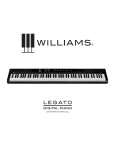
![Overture 2 Owner`s Manual [US]](http://vs1.manualzilla.com/store/data/005690862_1-0f7bb48baaf3473aa086657512069e12-150x150.png)
![Rhapsody 2 Owner`s Manual [US]](http://vs1.manualzilla.com/store/data/005663417_1-92bddf67d752d586c47af9cd7ea47d7e-150x150.png)
